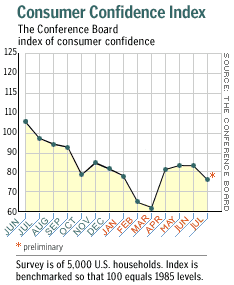NEW YORK (CNN/Money) - As exciting as Wednesday's report of strong U.S. retail sales was, in many ways it was the same old story the economy's been telling for months: Consumers pulling a stubborn, sluggish economy behind them, waiting for businesses to take some of the load by spending more money and hiring workers.
Many economists believe today's strength in consumer spending will equal tomorrow's labor-market rebound. Others aren't so sure.

"The idea that the recovery has started has been clearly confirmed," said Lehman Brothers chief economist Ethan Harris. "But there's no way to know the sustainability of the recovery."
The Commerce Department said retail sales in July were much stronger than most economists expected, and they revised sharply upward the data from May and June.
Since consumer spending makes up more than two-thirds of total gross domestic product (GDP), the broadest measure of the economy, economic growth should be much stronger in the second half of the year than the anemic 1.4 percent annual rate it clocked in the first quarter or even the second quarter's 2.4 percent rate.
"Real GDP in the third quarter and into the fourth will clear 4 percent," Brian Wesbury, chief economist at Griffin Kubik Stephens & Thompson, a Chicago investment firm, told CNNfn. "The economy has recovered after the war very strongly."
Businesses need to take the baton
A boom in mortgage refinancing, which homeowners used to cut their monthly payments and tap into their swollen home equity, accounted for some of the robust spending. The tax cuts passed earlier this year, which showed up in paychecks in July, helped as well.
| Related stories
|

|
|
|
|
But interest rates are rising, spelling the end of the refi boom, and the consumer-spending boost from tax cuts has a limited life expectancy.
After that, businesses will have to start hiring people, which they've been reluctant to do so far, even though the economy has grown, and consumers have spent, since the latest recession ended in late 2001. Many economists think that moment has finally come.
"After a couple of false starts, the past couple of months does have the feel of a more traditional recovery, driven by consumer spending and housing," said Mickey Levy, chief economist at Bank of America. "The follow-through is the business response."
Still, Levy pointed out that, even as businesses ramp up production and boost inventories to keep up with rising demand, they still will be slow to increase their hiring.
Many economists think the labor market needs to add more than 100,000 jobs every month to keep the unemployment rate from rising, and it seems highly unlikely such job growth will start right away, since businesses need time to make hiring plans, place help-wanted ads and interview people.
"I expect employment to increase, but I also expect the unemployment rate to remain pretty high," Levy said. "We'll get [the rate lower], but it will take time."
How long can consumers wait?
So one big question is whether or not consumers will keep spending until hiring kicks in, and economists are divided about consumers' ability to remain patient in the face of the longest stretch without sustainable job creation since World War II.
"With job-market conditions being what they are, I don't see how consumers will be out there spending up a storm in coming months," said Richard Yamarone, chief economist at Argus Research Corp.
Another big question, of course, is whether businesses will do much hiring at all. After the "productivity miracle" of the late 1990s, driven mainly by investment in new technology, companies have learned they can squeeze more work out of fewer workers, and a growing number of firms are now looking overseas for cheaper labor to help meet rising demand while keeping costs low.
If businesses come out of this period of increased demand with labor forces still lean, some economists worry consumers will finally drop their share of the economic load.
"The weakness in the labor market is clearly reducing the growth of earnings, meaning consumers, most of who depend on their paychecks, are likely to remain insecure about where the economy is headed," said Jared Bernstein, labor economist at the Economic Policy Institute, a Washington think tank. "This in turn has the potential to constrain consumption growth, limiting the boost that the economy will get from the recent tax cut, and delaying the arrival of a truly self-sustaining recovery."

|

